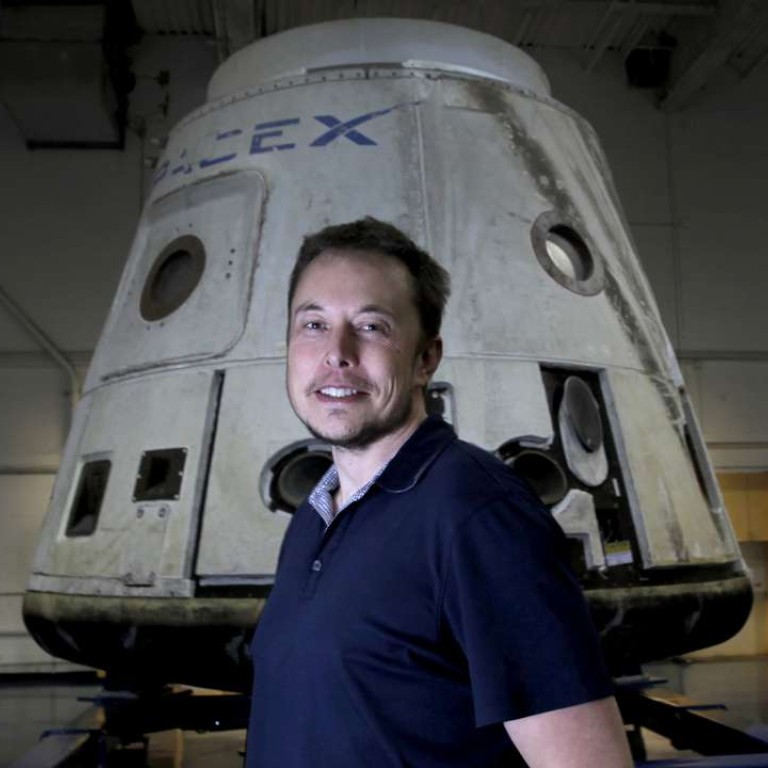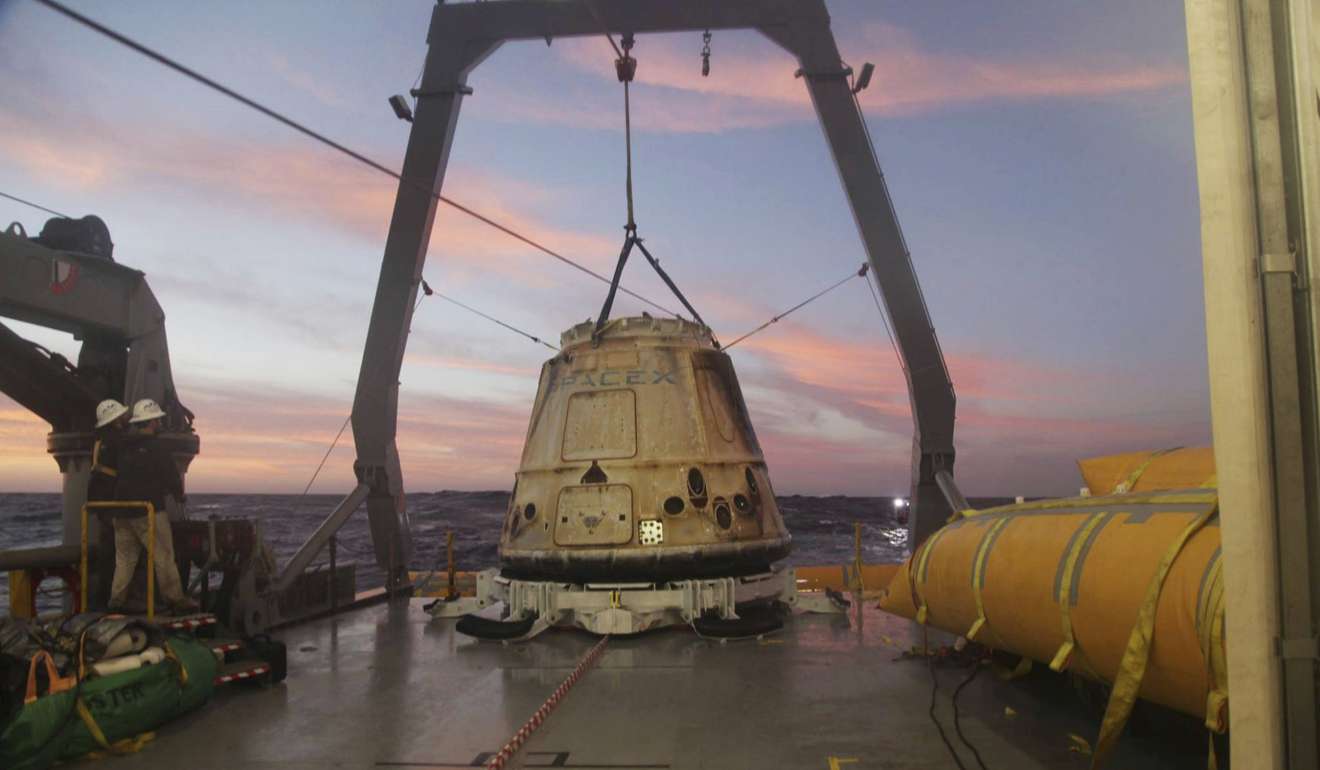
SpaceX announces it will fly two people around the moon next year, a feat not tried since 1968
When the first astronauts travelled to the moon, they were experienced military fliers riding Nasa rockets and capsules, backed by the US government.
Forty-five years after the last Apollo moon mission, in what would be a first, SpaceX plans to fly two private citizens around the moon atop one of the company’s own rockets. And, SpaceX says, the cost will be paid out of the astronauts’ own pockets.
In typical fashion, SpaceX’s audacious billionaire founder and chief executive, Elon Musk, provided few details about the expedition. Musk wouldn’t say who will make the flight in late 2018, how much it will cost in total or how much the astronauts are paying.
He did say that the two individuals had come to him and asked if SpaceX would set up the flight, and that they are “nobody from Hollywood.” They’ve put down their deposits and will start fitness tests and training later this year.


“This should be a very exciting mission that hopefully gets the world really excited about sending people into deep space again,” Musk said a conference call with reporters.

The lunar mission will be launched from Launch Complex 39A at Kennedy Space Centre in Florida. Pad 39A was the launch pad for Apollo and space shuttle missions. The last moon landing mission, Apollo 17, left there in 1972.
“It’s not easy,” John Logsdon, professor emeritus at George Washington University’s Space Policy Institute, said of Musk’s plan.
“Remember, Elon last September said he was sending people to Mars in 2025. Compared to that, this is a slam dunk. But only compared to that.”
Musk said the aspiring astronauts know what they’re signing up for.

“I think they’re entering this with their eyes open,” he said. “We’ll do everything we can to minimize that risk, but it’s not zero.”
The weeklong moon shot would make a close fly-by of the moon’s surface, “go quite a bit further out into deep space” and then loop back to Earth, Musk said. The spacecraft will not try to land on the surface of the moon.
Musk said he thought that there was a market for two such missions per year, and that they could be a “significant driver of revenue” for the company.
Musk’s plans for deep-space travel — including his lofty goal of colonising Mars — are a step beyond recent space-tourism plans, said Bill Ostrove, aerospace and defence analyst at Forecast International.
“It creates a lot of publicity for the industry, which I think is important for continuing to generate interest both in terms of customers and investors,” he said.
Assuming that all of the space tourism companies succeed, Ostrove said there probably would be a place in the market for both the more frequent, suborbital flights and the longer-term, less-frequent lunar orbit missions.

It’s unclear whether Nasa would offer further help with a private moon mission — or will return to the moon itself.
SpaceX and Boeing Co. already are working with Nasa on the Commercial Crew programme. The two companies are developing capsules to ferry astronauts to the International Space Station. The first test flight of SpaceX’s Dragon capsule is set for November, with the first crewed flight test aimed at May 2018.
Once operational Crew Dragon missions are underway for Nasa, SpaceX says it will launch the private lunar mission. Musk said he would be willing to give Nasa the first chance to combine with SpaceX on a lunar orbit mission, if the space agency is interested.
“NASA would have priority in any lunar mission,” Musk said. “In the absence of that, it would just be two private individuals on board.”

NASA said in a statement Monday that it “commends its industry partners for reaching higher” and will work closely with SpaceX to make sure it “safely meets” its contractual obligations for transporting astronauts and supplies to the space station.
SpaceX will need a standard launch license from the Federal Aviation Administration’s Office of Commercial Space Transportation, said Logsdon at George Washington University.
Beyond that, there is currently no regulatory regime for private space flight. Although the FAA has been interested in extending its authority to further manage commercial operations in space, that idea has not gained political traction in either the executive office or in Congress, Logsdon said.
SpaceX’s news follows an announcement from Nasa on February 15 that the agency would look into the possibility of putting crew on the first flight test of its massive Space Launch System rocket and Orion crew capsule in 2019, which was scheduled to orbit the moon.

That first flight was initially intended to be done without a crew. But US President Donald Trump has indicated that he wants to put his mark on the space programme, possibly by orbiting and then landing on the moon.
“The crux of the matter is that we have a commercial company, SpaceX, that is far ahead of the government-funded programme, the Orion programme,” said Peter Diamandis, founder of the Xprize Foundation, which is best known for its $10 million Ansari Xprize to encourage private space flight.
“The question is … at what point does the government stop competing with private industry? That’s the debate we’ll be having,” Diamandis said.
“I think we are on the verge of opening the space frontier and thousands of years from now we’ll look at these next few decades as the time the human race moved irreversibly off the planet.”
Musk has promised breakthroughs in space technology before. He has mostly delivered, although not always in the time frame he initially announced. Last September, the company suffered a setback when one of its Falcon 9 rockets exploded on a launch pad in Florida. The company resumed launches last month.
Watch: video captures fiery blast of SpaceX rocket failure
At least one analyst wouldn’t be surprised to see Musk’s timetable slip.
“SpaceX has a lot of challenges on its plate this year,” said Charles Lurio, writer and publisher of space newsletter the Lurio Report. “Which doesn’t mean they can’t do it. I just think it’s probably more likely they’ll do it a little later than they’re currently projecting.”
Gerald Blackburn, 72, knows what kinds of pressures SpaceX will be under to deliver. In 1964, he started working on the Apollo programme as an engineer for North American Aviation in Downey, Calif. He continued to work on the capsules until the end of the Apollo programme and then transitioned to working on the space shuttle programme.
“Early in the Apollo programme, we struggled with a lot of failures and losses, in terms of how this hardware was going to function and all of the technical problems associated with it,” Blackburn said. “And each one that was solved, there would be half a dozen more that would crop up, and you would have to go and solve those.”
He said it was important for SpaceX to take the time and do its work in a “timely and a safe manner.”
“You don’t rush things,” Blackburn said. “When you start rushing the programmes and expectations, that’s when mistakes are made.”
A mission to the moon is much different and farther than going to the space station, he said.
“I think if anybody can do it, SpaceX can.”


